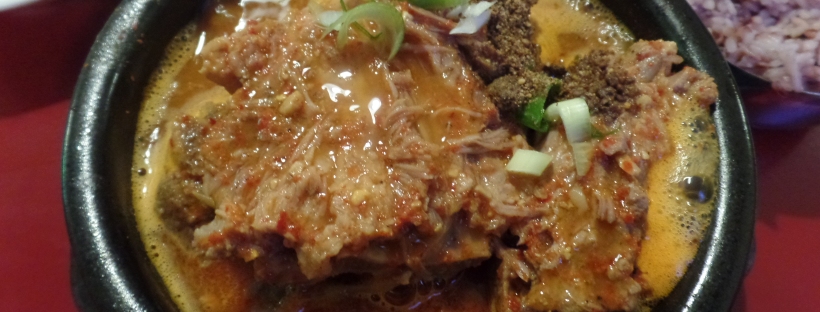Gam ja tang (Pork Bone Soup)
A traditional Korean soup/stew that is made out of pork neck bones and is usually added with vegetables like potatoes, cabbages and green onions. It is also served with rice, kimchi, sprouts, and seaweeds.
So it was a Sunday evening, me and my friend just watched a movie at the Cineplex and it was past 10pm at that time. We haven’t eaten anything for dinner. I asked my friend if she knows any interesting restaurants that we can go to for dinner. This was also great because I need to do this Sensory Evaluation for my assignment for my Theory of Food I class. So she suggested a Korean restaurant that was near Finch station and she wanted me to try her favourite dish that she always craves to eat. This was the second time I went to a Korean restaurant, the first time was when me and my family went to eat for Korean barbecue.
The first thing I asked her is, “Is it spicy?” because I don’t really like spicy foods. I personally don’t like spicy foods because I feel like I cannot taste the food other than the spiciness. She said that it is spicy but not too much. I was a bit hesitant at first because I may not enjoy it when I take the first bite. But she kept insisting me to try it so I just said, “Ok let’s go”.
When the soup came to our table, visually I can easily tell that it was spicy because of the red- orangey colour and it was still boiling! I saw that there were still little bubbles that was forming on the side of the bowl. Even just by smelling it, I can smell that the red peppers that was from the soup. It smelled really good though or maybe because it was 11 pm in the evening and I was so hungry. Also when I look at it, it doesn’t look as appetizing as I expected because all I can see was pork bones. I wasn’t even sure if there’s going to be some meat in the soup. The server also gave us some side dishes like rice, seaweed, kimchi, sprouts and etc. When it came for the tasting of the soup, I just took a tiny amount on my spoon. And my initial though was, “It’s not that bad”. The soup had the right amount of spiciness that I liked and also it had a kick to it. It was also very meaty probably because they use pork bones which gave lots of flavours. I’m not sure if that’s what umami means but the soup really had strong flavours when I tasted it. It had the right amount of seasoning and there was also this powder that looks like pepper (but it’s not) that added a little bit of sweetness in the soup. I looked it up on the internet and it is called Perilla seed powder. You can find it at Korean/Asian markets. As I continued eating it, I really enjoyed the soup. I didn’t even mind that I was sweating a little bit. I would definitely come back and have some more next time. Now I get it why my friend really love this food. Like what I said, it doesn’t look that appetizing at first but when you taste it, BOOM! it was bursting with flavours.
What did I learned about my palate?
Just like Chef Brown (who is one of my instructors) said, learning about our palates is a process. There is a lot more about our palates than just tasting a food. We also need to use our other senses such as smell and vision. Our palate can also be one of the important things on what can make someone be a great chef. This experience made me more aware about my taste buds. It made me analyze the food that I eat and also appreciate the flavours that is from our food.
Ro, B. H. (2016, April 03). Gamjatang (Spicy Pork Bone Stew) – Korean Bapsang. Retrieved September 26, 2016, from http://www.koreanbapsang.com/2016/04/gamjatang-spicy-pork-bone-stew.html
Hemer, L. (2014, October 29). Gamjatang ~ Korean Pork Bone & Potato Soup. Retrieved October 01, 2016, from http://cookandbemerry.com/gamjatang-korean-pork-bone-potato-soup/





